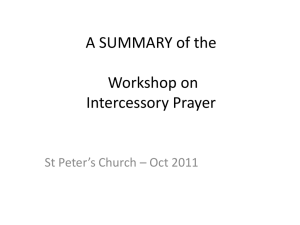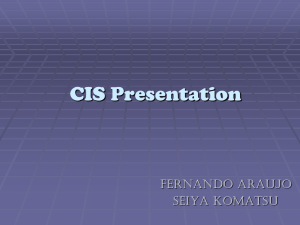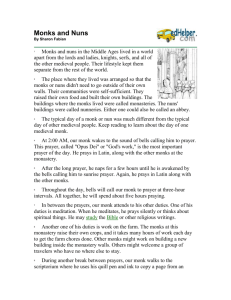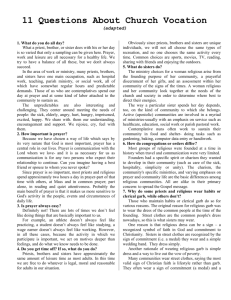Living Life with the Early Church
advertisement
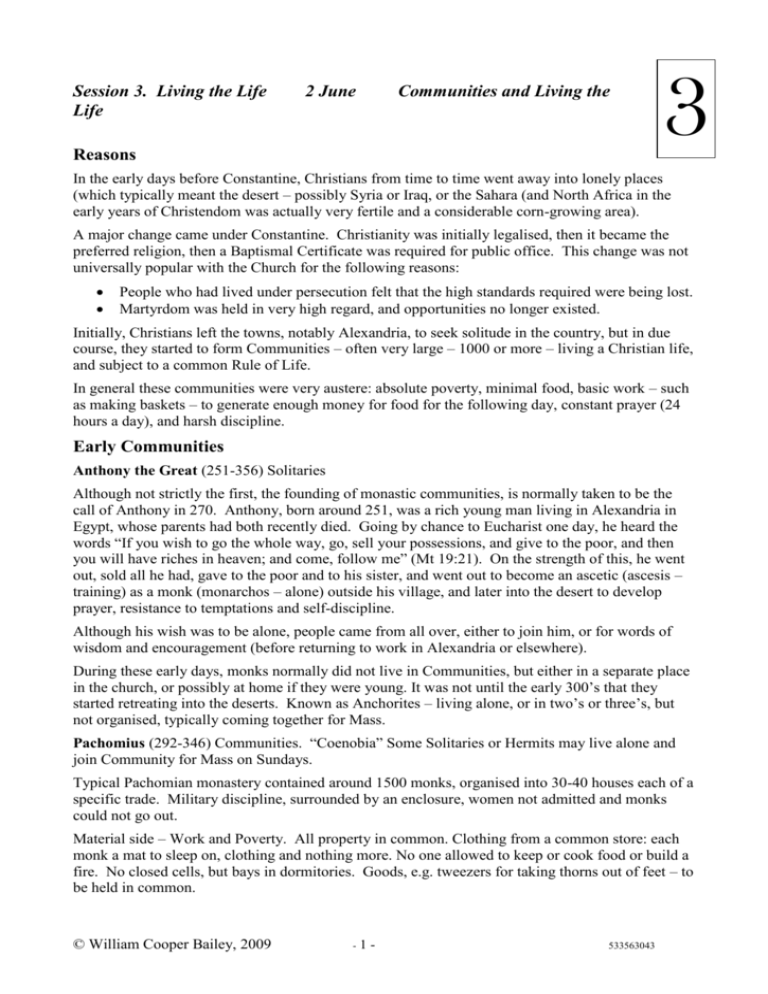
Session 3. Living the Life Life 2 June Communities and Living the Reasons 3 In the early days before Constantine, Christians from time to time went away into lonely places (which typically meant the desert – possibly Syria or Iraq, or the Sahara (and North Africa in the early years of Christendom was actually very fertile and a considerable corn-growing area). A major change came under Constantine. Christianity was initially legalised, then it became the preferred religion, then a Baptismal Certificate was required for public office. This change was not universally popular with the Church for the following reasons: People who had lived under persecution felt that the high standards required were being lost. Martyrdom was held in very high regard, and opportunities no longer existed. Initially, Christians left the towns, notably Alexandria, to seek solitude in the country, but in due course, they started to form Communities – often very large – 1000 or more – living a Christian life, and subject to a common Rule of Life. In general these communities were very austere: absolute poverty, minimal food, basic work – such as making baskets – to generate enough money for food for the following day, constant prayer (24 hours a day), and harsh discipline. Early Communities Anthony the Great (251-356) Solitaries Although not strictly the first, the founding of monastic communities, is normally taken to be the call of Anthony in 270. Anthony, born around 251, was a rich young man living in Alexandria in Egypt, whose parents had both recently died. Going by chance to Eucharist one day, he heard the words “If you wish to go the whole way, go, sell your possessions, and give to the poor, and then you will have riches in heaven; and come, follow me” (Mt 19:21). On the strength of this, he went out, sold all he had, gave to the poor and to his sister, and went out to become an ascetic (ascesis – training) as a monk (monarchos – alone) outside his village, and later into the desert to develop prayer, resistance to temptations and self-discipline. Although his wish was to be alone, people came from all over, either to join him, or for words of wisdom and encouragement (before returning to work in Alexandria or elsewhere). During these early days, monks normally did not live in Communities, but either in a separate place in the church, or possibly at home if they were young. It was not until the early 300’s that they started retreating into the deserts. Known as Anchorites – living alone, or in two’s or three’s, but not organised, typically coming together for Mass. Pachomius (292-346) Communities. “Coenobia” Some Solitaries or Hermits may live alone and join Community for Mass on Sundays. Typical Pachomian monastery contained around 1500 monks, organised into 30-40 houses each of a specific trade. Military discipline, surrounded by an enclosure, women not admitted and monks could not go out. Material side – Work and Poverty. All property in common. Clothing from a common store: each monk a mat to sleep on, clothing and nothing more. No one allowed to keep or cook food or build a fire. No closed cells, but bays in dormitories. Goods, e.g. tweezers for taking thorns out of feet – to be held in common. © William Cooper Bailey, 2009 - 1- 533563043 Regularity of Prayer paramount. When trumpet sounds, monk drops everything, starts praying mentally and makes for place of prayer. Punctuality, order, discipline. Penances for latecomers, not immediately correcting a fault of a subordinate, arguing, lateness, idleness, taking items assigned to others or from the common store. Writings – the above experiences were much valued and people came to see them and write 3 o Sayings of the Desert Fathers. 300-500 Assorted, especially collections by Benedicta Ward. Very terse reflections mainly by hermits. o Ladder of Divine Ascent 525-606 (Abbot John Climacus of St. Catherine’s Mount Sinai). Standard reference work in Orthodox Church of the East today (especially Fourth Sunday of Lent) o Ascetical Homilies of Isaac of Nineveh 356-460 (the Syrian). Oriental churches. o Conferences and Institutes of John Cassian 360-430 (Catholic West – Born Romania, trained Bethlehem, founded monasteries in France) Subsequent Developments o Rule of Benedict (480-543). Translated Cassian into a monastic organisation manual. Still in everyday use in monasteries, companies, offices and homes. Promoted in West by Charlemagne. Recommended Cassian and Early Fathers. Focus on prayer and work to support community. Library important. Enclosure based. Bede was a Benedictine. Twelfth Century Innovations o Cistercians. More ascetical, simple and austere derivation of Benedictine. Wilds of country. Aelred of Rievaulx (1109-1167) was a Cistercian, which was very popular in Yorkshire. o Franciscan – Francis of Assisi (1182-1226) Helping the poor and destitute. and others. Religious Communities Today Still exist worldwide. Traditional ones have lifetime vows and absolute poverty: o Roman Catholic Cockfosters, Ealing, Central London o Orthodox Stevenage, Maldon (Essex) o Anglican Benedictines: Edgware, Newbury, Alton, West Malling, Franciscans various communities, Others: Central London, Ham, Crawley Down, Mirfield etc. o Lutheran … and many others (many without lifetime vows) Iona, Northumbria and others. Contain: o Monks or nuns (occasionally mixed). Lifetime professed, novices, postulants. o Lay brothers, sisters or others who do specific work in Community factory etc. o Oblates, Companions, Associates, Tertiaries – people lining in the world with a regular prayer or other link with one or more Communities. Typically a Rule of Life. Very popular in 21st century. Retreats and quiet days. Rather like residents in Alexandria in 4th century. o Some communities informal Christian houses of many kinds; no lifetime vows. Rule of Life: varies, but typically contains: (note: probably what many would do anyway) o o o o o o Regular Bible reading Regular prayer – daily offices and prayer for the Community. Regular attendance at Holy Communion Visits to Community. Retreats and conferences either in Community or elsewhere. Sharing of skills, resources Spiritual Direction – often from member of Community, Sacramental confession as appropriate. o Probationary period, the undertake the Rule for life or fixed period (usually renewable) Where to start © William Cooper Bailey, 2009 - 2- 533563043 o One’s own home. Communities can supplement home church. Standard in Orthodox Church. o Visits and links. Many different types and natures. © William Cooper Bailey, 2009 - 3- 533563043





